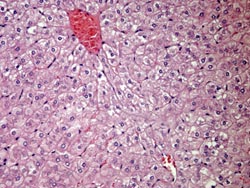Liver Tumours
A tumour is a "lump" which may be benign or malignant (cancerous). Many different tumours may be found on the liver and investigating them is an important task which often requires specialist imaging. Usually a confident diagnosis can be made with ultrasound, CT or MRI scans. Occasionally a biopsy will be necessary (small sample of the tumour taken with a needle for microscopic analysis).
Benign Liver Tumours
Benign liver tumours are quite common and often noticed incidentally on scans performed for other reasons.
The most common benign liver tumours are:
- Liver cysts
- Haemangioma (abnormal collections of blood vessels)
- Focal Nodular Hyperplasia (abnormal collection of liver cells with a central scar)
- Hepatic adenoma (a growth of liver cells which may be important due it's potential to develop into liver cancer)
Most benign liver tumours do not need treatment. Liver adenoma may need surgery due to their potential to progress to cancer or cause internal bleeding.
See also:
Malignant Liver Tumours
Malignant (cancerous) tumours of the liver may be either primary (originating in the liver) or secondary (spread to the liver).


Primary liver cancer is known as hepatocellular carcinoma or hepatoma. The majority of hepatoma develop in livers with underlying cirrhosis. There are many different treatment modalities for hepatoma including surgical resection, drug therapy, local ablation (burning) or liver transplantation. All hepatoma are discussed in a multidisciplinary meeting at the Austin with surgeons, hepatologists (liver specialists), oncologists and radiologists present.
Secondary cancers in the liver are more common than primary and may have originated in many different organs. If bowel cancer spreads to the liver, surgery is often indicated. In rare circumstances other (non bowel) cancers which have spread to the liver may need surgery. All secondary liver cancers are discussed in a multidisciplinary meeting at the Austin with surgeons, oncologists, pathologists, nuclear physicians and radiologists present.
Primary liver cancer: http://en.wikipedia.org/wiki/Hepatocellular_carcinoma
Colorectal liver metastases: http://www.cancer.umn.edu/cancerinfo/colorectalmetastasis.html
Areas of Speciality
Memberships

- Fellow of the Royal Australasian College of Surgeons
- Certificate in Post-fellowship training in transplant surgery
- Member of International Hepato-Pancreato-Biliary Association
- Member of Australian and New Zealand Hepatic, Pancreatic and Biliary Association
- Member of International Liver Transplantation Society
- Member of Transplantation Society of Australia and New Zealand
Save Lives - Become An Organ Donor
 Australia is a world leader in successful organ transplants but a shortage of donors means that around 1600 people are waiting at any one time for a life-saving or life-improving transplant.
Australia is a world leader in successful organ transplants but a shortage of donors means that around 1600 people are waiting at any one time for a life-saving or life-improving transplant.
